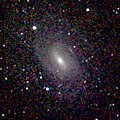Top Qs
Timeline
Chat
Perspective
NGC 6384
Galaxy in the constellation of Ophiucus From Wikipedia, the free encyclopedia
Remove ads
NGC 6384 is an intermediate barred spiral galaxy located about 77 million light-years away in the northern part of the constellation Ophiuchus. It was discovered on 10 June 1863 by German-British astronomer Albert Marth.[5]
NGC 6384 has a morphological classification of SAB(r)bc,[4] indicating that it is a weakly barred galaxy (SAB) with an inner ring structure (r) orbiting the bar, and moderate to loosely wound spiral arms (bc).[6] The galaxy is inclined by an angle of 47° to the line of sight, along a position angle of 40°.[7] The estimated mass of the stars in this galaxy is 105 billion times the mass of the Sun.[4]
At one time NGC 6384 was considered a normal galaxy with no activity in the nucleus. However, it is now classified as a transition object (T2), which is thought to be a LINER-type galaxy whose emission-line spectra is contaminated by H II regions in the nucleus.[8]
Remove ads
Supernovae
Three supernovae have been observed in NGC 6384:
- SN 1971L (Type Ia, mag. 13) was discovered by W. Logan on 24 June 1971, located 27″ east and 20″ north of the nucleus.[9][10] It reached a peak visual magnitude of 12.85 around the end of June.[11] It was situated along a spiral arm, suggesting that the progenitor was not a member of the older, more evolved stellar population of the galaxy.[7]
- SN 2017drh (Type Ia, mag. 17.9356) was discovered by the Distance Less Than 40 Mpc Survey (DLT40) on 3 May 2017.[12]
- SN 2024pxl (Type Iax[02cx-like], mag. 17.668) was discovered by the Zwicky Transient Facility on 23 July 2024.[13]
Remove ads
Gallery
References
External links
Wikiwand - on
Seamless Wikipedia browsing. On steroids.
Remove ads



